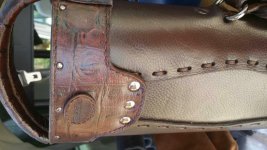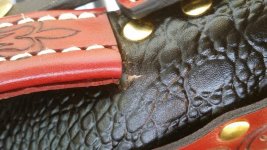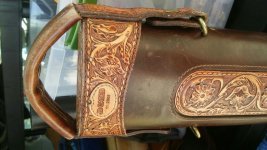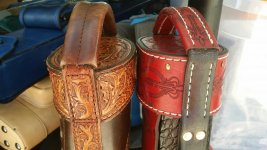Leather working methods.
There are many ways to work with leather. It's really one of the oldest and most versatile materials. Leather is available to every human and the methods of making it are ancient. Now of course humans generally don't hunt their own food and so they don't end up with skin that they need to tan. So let's skip ahead to leather products and the various ways that they are made today since most of us are consumers who buy those products ready made.
The point of this discussion is to make you familiar with the various methods that a cue case can be constructed. Not talking about protection here, I am talking about the way it's put together and why certain methods are used.
A case can be as simple as folding any piece of leather over and sewing up the open side - you have a leather container. Or it can be as complicated as cutting many parts to exact measurements and carefully assembling them.
All leather is not equal. Just because a product is said to be leather doesn't mean it's good leather or well constructed. "Leather" does evoke a certain amount of comfort and durability in people's minds but the fact is that leather itself while a great and versatile material has a wide range of qualities, not all of which are suitable for all uses.
Leather is heavy as well. So figuring out the best way to bind heavy material is not always an easy chore. Sewing is generally thought to be the best way and the double needle saddle stitch is considered to be the strongest sewing method. This is because when done properly the saddle stitch is essentially a knot at each stitch point meaning that if one spot breaks the rest of the line maintains strength. This method of sewing is also the most labor intensive. Machine stitching though is just as strong when done right and important to remember that military gear is all machine sewed.
So not all hand sewing is automatically strong or properly done. Nor is all machine sewing weaker.
----------------------- I have to go for now so this is where I will stop for the moment. ----- I will update this post later with more information and pictures and videos - let you know when -
Ultimately the goal here is for you - the consumer to be able to pick up any cue case and be able to inspect it thoroughly armed with real factual knowledge - so that YOU can decide if it's worth your money or not.
There are many ways to work with leather. It's really one of the oldest and most versatile materials. Leather is available to every human and the methods of making it are ancient. Now of course humans generally don't hunt their own food and so they don't end up with skin that they need to tan. So let's skip ahead to leather products and the various ways that they are made today since most of us are consumers who buy those products ready made.
The point of this discussion is to make you familiar with the various methods that a cue case can be constructed. Not talking about protection here, I am talking about the way it's put together and why certain methods are used.
A case can be as simple as folding any piece of leather over and sewing up the open side - you have a leather container. Or it can be as complicated as cutting many parts to exact measurements and carefully assembling them.
All leather is not equal. Just because a product is said to be leather doesn't mean it's good leather or well constructed. "Leather" does evoke a certain amount of comfort and durability in people's minds but the fact is that leather itself while a great and versatile material has a wide range of qualities, not all of which are suitable for all uses.
Leather is heavy as well. So figuring out the best way to bind heavy material is not always an easy chore. Sewing is generally thought to be the best way and the double needle saddle stitch is considered to be the strongest sewing method. This is because when done properly the saddle stitch is essentially a knot at each stitch point meaning that if one spot breaks the rest of the line maintains strength. This method of sewing is also the most labor intensive. Machine stitching though is just as strong when done right and important to remember that military gear is all machine sewed.
So not all hand sewing is automatically strong or properly done. Nor is all machine sewing weaker.
----------------------- I have to go for now so this is where I will stop for the moment. ----- I will update this post later with more information and pictures and videos - let you know when -
Ultimately the goal here is for you - the consumer to be able to pick up any cue case and be able to inspect it thoroughly armed with real factual knowledge - so that YOU can decide if it's worth your money or not.





